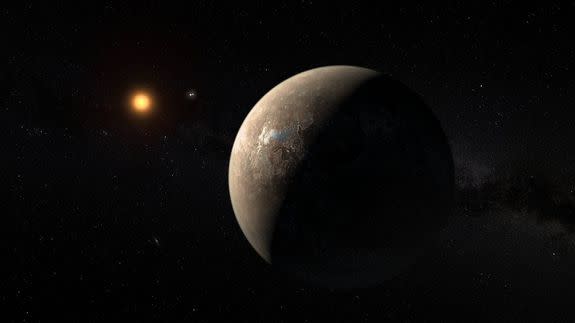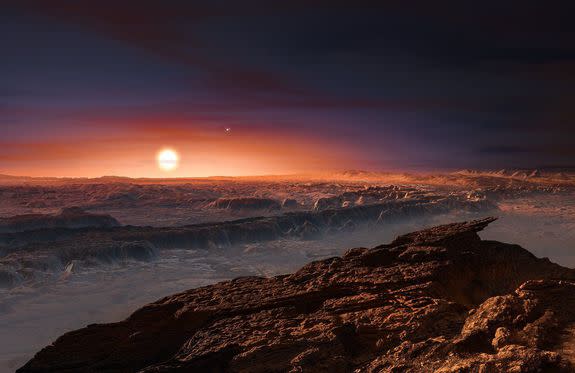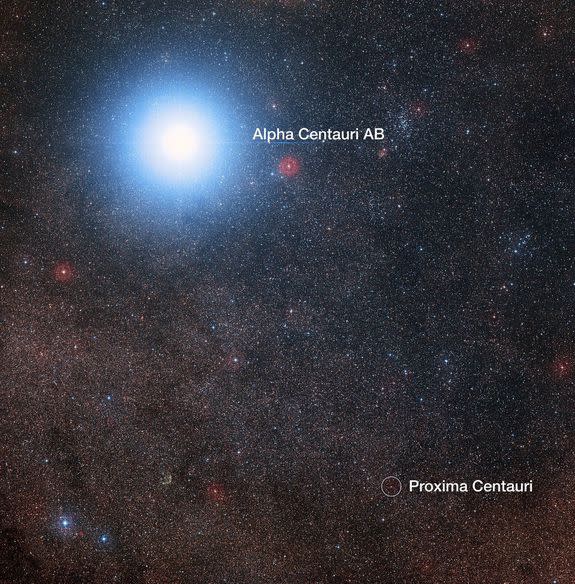Potentially Earth-like planet found orbiting our neighboring star

The dim, red light of a small star illuminates the rocky surface of a world just four light-years from Earth.
This newfound alien planet, or exoplanet, may have a life-supporting atmosphere or it could simply be an irradiated rock not far from our solar system. But either way, the planet — known as Proxima b — is the closest world yet discovered outside our solar system.
A new study published Wednesday in the journal Nature details the discovery of the rocky, potentially Earth-like planet orbiting the star Proxima Centauri, the closest star to our sun which may be part of the Alpha Centauri system of stars.
SEE ALSO: 104 newfound alien planets confirmed in cosmic haul
"If further research concludes that the conditions of its atmosphere are suitable to support life, this is arguably one of the most important scientific discoveries we will ever make," co-author of the study John Barnes said in a statement.
Scientists discovered the planet candidate by using telescopes operated by the European Southern Observatory, as well as earlier observations of Proxima Centauri.
Those telescopes detected small wobbles of the star, which they concluded was likely due to the small tug of Proxima b's gravity. The study's authors saw that the star seems to wobble in a consistent pattern, which allowed them to effectively measure the planet's approximately 11-day orbit around the star.
That may seem like a very close-in orbit, considering that Earth's orbit around the sun takes far longer, at 365 days.
However, because of Proxima Centauri's size, Proxima b, which is thought to have a mass about 1.3 times that of the Earth's, still has a shot at habitability.
The star — known as an M-dwarf — is much cooler and dimmer than the sun, meaning that the star's "habitable zone," the orbit in which a planet could host liquid water on its surface, is quite close to the star.
This discovery of an alien world so close to our own solar system certainly sparks the imagination, calling to mind possible interstellar voyages that could deliver us to Proxima b and whatever strange aliens that may await us there.
"As a human, I would love this planet to be a planet that has an atmosphere and possibly could have liquid water and possibly could have some kind of life," NASA astronomer Steve Howell, who was not involved in the new research told Mashable in an interview.
"As a scientist, you know, it's one of a number of planets we need to study in great detail."
A long way to Earth-like
While this finding is exciting, it's not exactly the holy grail for exoplanet hunters.
For years, scientists have been searching for an Earth-like planet orbiting a star like our sun, a world that they might be able to point to and say, "this is our best shot for finding possibly advanced life outside of the solar system."
"I am still holding out for the true Earth analog orbiting the sunlike star," exoplanet scientist Sara Seager, an astronomer at MIT who was not involved in the new research, told Mashable via email.

Image: ESO/M. Kornmesser
Although Proxima b is an example of a world that might be habitable, there are still a lot of questions to answer before researchers can say that with a high degree of confidence.
For example, scientists still aren't sure exactly what kind of atmosphere, if any, envelops the planet. The planet might be more like Venus, with a thick atmosphere that makes the planet unlivable, or it could have no real atmosphere to speak of.
It's possible that the planet might be just right for life to develop, but even then, the world is tidally locked to its star, meaning that the same face of the planet constantly points toward the star.
Instead of rotating while orbiting like Earth does, Proxima b has a constant "day side" and "night side," which is more like the moon.
The researchers still aren't sure if the planet has a magnetic field, which would help protect it from Proxima Centauri's violent flares.

Image: Digitized Sky Survey 2 Acknowled
In the coming years, researchers will use ground-based observatories and even spacecraft in space to learn more about the new possible world orbiting Proxima Centauri.
According to Howell, in about 20 years, astronomers may even be able to remotely measure an atmosphere of an alien planet.
Because Proxima b is so close to Earth, it's possible that scientists will be able to catch sight of it and learn more about it by snapping photos.
"One could ... attempt to detect the reflected or radiated light from the planet directly — this can be done only for nearby planets," astronomer Artie Hatzes, a scientist unaffiliated with the new study, wrote in a Nature analysis about the findings.
"Because Proxima Centauri is relatively close to us, such attempts have a reasonable chance of succeeding. In the distant future, an interstellar space probe might get a close-up look at the planet."
The history of the star and its planet
The possible habitability of Proxima b really hinges upon the history of the star system and its planet.
Scientists think that at least some stars like Proxima Centauri are known to be somewhat temperamental early in life, shooting off flares that can strip a small world of its atmosphere and leave it as an uninhabitable, orbiting rock.
However, M-dwarfs also live much longer than more massive stars like our sun and they can quiet down after their turbulent adolescent years.
This means that if a planet's prospects for habitability can remain through the turmoil of the star's early days, it's possible that life will have the chance to develop on a world bathed in the cool light of a red star.
In many ways, Proxima b's chances for life hinge on whether it was in a safe zone during the potentially more active early days of Proxima Centauri's life, the authors say.
M-dwarfs and the future of exoplanet hunting
This discovery may spur more astronomers to take a look at other red stars that might play host to planets.
This finding gives scientists the added benefit of gathering more data about these types of stars, helping to characterize these little-studied but numerous objects in the universe.
"We'll learn lots more about M-stars, and if you have a close-by M-star like this and you think it has a planet, everybody's going to want to look at it," Howell said.
"So, this particular star will now be the golden child of stars, and everybody will think of some way to observe this star to learn something."
This new discovery could mark the start of a sea-change in exoplanet science.
NASA's exoplanet-hunting Kepler telescope is still searching for planets outside our solar system, but unlike an earlier part of its mission — which was defined by staring deeply at a relatively small part of the sky — the spacecraft is now gazing along a wider patch.
"With the pioneering Kepler flood of data nearly behind us, we will see the field return to intense study of individual stars or exoplanets," Seager said.
"The Proxima Centauri discovery heralds this new era."
